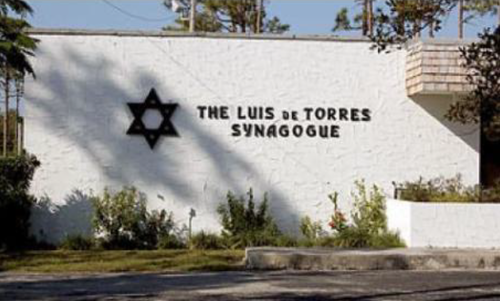Yosef ben Halevy
03/27/2019 10:42:45 AM
Dr. Mariana Montiel
| Author | |
| Date Added | |
| Automatically create summary | |
| Summary |
Yosef ben Halevy was born in Huelva, a province of Andalucia, although the exact date of his birth is not known. He was versed in Hebrew, Aramaic, Latin, Mozarabic and Arab, as well as the Castellano (Spanish), Portuguese, and French of the 15th century. Because of his erudition in languages he was the Governor of Murcia’s official translator. However, when his presence was required by Cristopher Columbus, the governor agreed to let him accompany the navigator on his first voyage.
Yosef Ben Halevy was forced to convert to Catholicism so as to be allowed to set sail with Christopher Columbus. He converted on August 1, 1492, the day before the departure of the Pinta, the Niña, and the Santa Maria on August 2 of that year. That exact date, August 2, 1492 was also the limit date for the Jewish population of Spain to convert or to leave the country, before the death penalty would be applied. Yosef Ben Halevy became Luis de Torres, and this is the name which by he is known as Columbus’s Jewish translator.
The question of why Columbus would want an interpreter fluent in Hebrew can be explained in the following way. As Columbus thought he would arrive to India and continue through Asia, he knew that Jewish merchants and traders, known in the early middle ages as Radhanites, had traced trading routes from Baghdad to China and he thought that it would be essential to be able to communicate with the Jewish merchants who continued that tradition. It is also assumed Columbus thought he might find lost Jewish tribes, or at least descendants and communities due to the Jewish presence during centuries along what we now call the “Silk Road”.
When Columbus and his crew arrived to present day Cuba, Luis de Torres was sent together with another sailor to inspect the area and look for the Great Khan, mentioned in the travel journals of Marco Polo. They were well received by the local natives and were introduced to the custom of smoking tobacco.
Columbus returned to Spain in January of 1493. Luis de Torres  and 38 other members of the first trip decided to stay in the settlement they called “El Fuerte de la Navidad”, the first settlement established by Spaniards in America, found on the Island of Hispaniola (an island shared in modern times by Haiti and the Dominican Republic). However, when Columbus arrived to the settlement on his second trip, all 39 had been eliminated due to internal division and problems with the native population.
and 38 other members of the first trip decided to stay in the settlement they called “El Fuerte de la Navidad”, the first settlement established by Spaniards in America, found on the Island of Hispaniola (an island shared in modern times by Haiti and the Dominican Republic). However, when Columbus arrived to the settlement on his second trip, all 39 had been eliminated due to internal division and problems with the native population.
Nevertheless, there is still no true agreement as to the measure of Luis de Torres´s role in the discovery of America, and according to some scholars he actually became a rich man in the New World and wrote his memories, although the majority claim that those memories were from another settler. Others say that he pronounced the first words of a European in America, and that he did so in Hebrew! Another anecdote assures that he gave the turkey its name, as in Hebrew “tukki” is an exotic bird.
In the Bahamas today, in Freetown, there is a synagogue named the Luis de Torres synagogue in honor of this Jewish personage, that some say is the pioneer of Judaism in America!
This month our pre and post expulsion stories come together in a special way. We will talk about the Sephardic presence in Jamaica, the island claimed by Christopher Columbus for the Spanish crown in 1503. This island, whose possession changed from Spanish to English rule in 1655, embodies a rich Jewish history.
The Spanish Inquisition, as we know, ordered any person who practiced the “Law of Moses” to be burnt at the stake. When the Dutch settlements in South America were reconquered by Spain and Portugal, many of the Jews that had established themselves on the continent fled to the Caribbean. These Jews played a fundamental role in Caribbean commerce, especially the sugar production and trade. In Jamaica the Jews were protected, at the beginning, by the descendants of Christopher Columbus, who had inherited the possession of the island.
However, the situation became very difficult for the Jews with the arrival of the Inquisition. The beginning and middle of the XVII century brought together several events that resulted in the conquest of Jamaica by the English and the end of Spanish rule on the island. The Jewish population played an important role in this change in many ways. One of the protagonists was Antonio Vaez Henriques, a prominent Lisbon merchant and crypto-Jew (Marrano). In 1605 he was publicly tortured together with 150 Jews, al accused of practicing their religion secretly. Antonio escaped to Amsterdam after this incident, where he changed his name to Moses Cohen Henriques and openly assumed his Judaism.
Although there are some scholars that are skeptical about this personage, Moses Cohen Henriques has passed on to history as a famous pirate. However, all say he was not a typical pirate, as he offered his services to the Dutch and English governments, and looked to attack Spanish and Portuguese ships as punishment for their treatment of the Jews.
The Jewish population of Jamaica became very prosperous under British rule and, at one point composed 20% of the residents of Kingston. Even so, for a long time the Jamaican Jews did not have full political rights. It was until 1830 when their leader, Moses Delgado, grandson of the Chief Rabbi of the London synagogue Bevis Marks, advocated for complete civil rights and the possibility to play a role in politics. By 1849, eight of the 47 members of the Jamaican Assembly were Jews and by 1866 there were 13 Jewish members, more than 25% of the delegates. Indeed, the Assembly did not work on Yom Kippur because so many delegates would not participate that day!
A Jamaican Jew, Jacob de Cordova, played an important role in the first days of the state of Texas. Jacob de Cordova, from Kingston, Jamaica, first arrived to Galveston, Texas in 1839. After living some years in this city, he moved to Houston, and was elected to the second Texas Legislature in the year 1847. In 1848 Jacob de Cordova was one of the founders and urban designers of Waco, another Texan city. However, his most important contribution to Texas consisted of the two books that he wrote, “The Texas Immigrant and Traveler’s Guide Book” (1856), and “Texas, Her Resources and Her Public Men” (1858).
After a devastating earthquake in 1692 the Jewish population of Jamaica bought land and, in 1704 constructed a Sephardic synagogue, Neve Shalom, in Spanish Town. This synagogue was based on the design of the recently completed synagogue Bevis Marks in London. Today, the only synagogue found on the island is Shaare Shalom, which is located in Kingston. Although it was built in 1912, it was constructed according the Spanish-Portuguese tradition of the time of Spanish rule, when the Jews had to hide the sound of their feet as they worshipped secretly. For this reason, it is one of the five synagogues in the world today that have sand floors, the others being found in Amsterdam, Curacao, Surinam and Saint Thomas.
The Matalon and Henriques families are, today, among the most economically active families of Jamaica and can trace their ancestors back to the original Jewish settlers. Other last names that indicate Jewish origin in Jamaica are Alexander, Barrett, Codner, da Silva, de Costa, de Leon, de Mercado, de Souza, Isaacs, Lindo, Lyon, Marish, Magnus, Pimentel, Rodriques, and Sangster.
Sat, July 27 2024
21 Tammuz 5784
Worship Services
Coming Soon at OVS
-
Thursday ,
AugAugust 8 , 2024Splatter & Schmooze
Thursday, Aug 8th 6:00p to 8:00p
Unleash your inner artist, get to know other young adults, and make a masterpiece to take home. After splatter painting, there will be an optional After Party at Battle & Brew next door. For young adults up to age 40. Standard Price $36. Optional After Party not included. -
Sunday ,
AugAugust 11 , 2024FunRaising Dinner - Clare and Robert Habif
Sunday, Aug 11th 6:30p to 8:30p
Join us for a Cuban dinner hosted by Clare and Robert Habif. All proceeds benefit OVS. -
Tuesday ,
AugAugust 13 , 2024Tisha B'Av
Tuesday, Aug 13th 8:00a to 10:00a
We will be observing Tisha B'Av on Monday, August 12 and Tuesday, August 13. -
Sunday ,
AugAugust 18 , 2024Welcome Back BBQ 2024
Sunday, Aug 18th 4:30p to 6:30p
Join us for a congregational welcome back BBQ at the Hearshen's house. RSVP by Monday, August 12. Park at OVS and take the shuttle bus. -
Sunday ,
AugAugust 25 , 2024Mitzvot Auction 2024
Sunday, Aug 25th 5:00p to 7:00p
Join us for our annual Mitzvot Auction and Keftes Dinner on Sunday, August 25 from 5:00 - 7:00 pm. Now featuring a live band of OVS musicians including Rabbi Hearshen, David Falkenstein, Hal Rabinowitz and Graham Levitas, a professional auctioneer and online purchasing. Dinner is $20 for adults, $5 for children ages 3-12. Children under 3 are free. Complimentary Childcare with advanced registration. -
Monday ,
SepSeptember 2 , 2024Apple Picking and Picnic Lunch
Monday, Sep 2nd 10:30a to 12:30p
Join us for a fun morning of picking apples for Rosh Hashana, visiting the petting zoo and more. Bring your lunch and join us for a picnic. Caravan from OVS at 9:00 am or meet at the orchard at 10:30 am at 9131 Highway 52 East, Ellijay, Georgia 30536. Members and non-members welcome. Participants will pay the orchard directly for entry and apples. -
Sunday ,
SepSeptember 8 , 2024Building Blocks Sunday School
Sunday, Sep 8th 10:00a to 12:00p
Building Blocks Sunday School at Congregation Or VeShalom is for children nursery age through 5th grade. Learning will focus on Sephardic Jewish heritage, holidays, Hebrew, and Israel education will be infused into the program. -
Sunday ,
SepSeptember 8 , 2024OVS Sisterhood Mezuzah Making Workshop
Sunday, Sep 8th 4:00p to 5:30p
OVS Sisterhood will join Rabbi Ruth Abusch-Magder and MACoM for Art and Uplift. Create a unique mezuzah to take home. $18 per person. Mezuzah parchment available for purchase. -
Sunday ,
OctOctober 6 , 2024Field Day 2024
Sunday, Oct 6th 11:00a to 5:00p
Intergenerational Field Day, including Tashlich service, will be held at Camp Ramah Darom. Registration fee includes gourmet lunch, snacks, a boxed dinner to take home and all activities. $18 per person.
Burekas & Biscochos
The Sephardic Cooks
My Preferences for Contact
Today's Calendar
| Shacharit : 8:46am |
| Mincha/Maariv : 7:40pm |
| Havdalah : 9:17pm |
This week's Torah portion is Parshat Pinchas
| Shabbat, Jul 27 |
Candle Lighting
| Shabbat, Jul 27, 8:23pm |
Havdalah
| Motzei Shabbat, Jul 27, 9:17pm |
Shabbat Mevarchim
| Shabbat, Aug 3 |
OVS Feature Video



